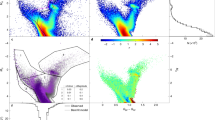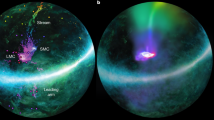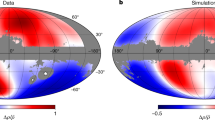Abstract
The Large Magellanic Cloud is the most massive satellite galaxy of the Milky Way, with an estimated mass exceeding a tenth of the mass of the Milky Way1,2,3,4,5. Just past its closest approach of about 50 kpc, and flying past the Milky Way at an astonishing speed of 327 km s−1 (ref. 6), the Large Magellanic Cloud can affect our Galaxy in a number of ways, including dislodging the Milky Way disk from the Galactic centre of mass7,8,9. Here, we report evidence that the Milky Way disk is moving with respect to stellar tracers in the outer halo in a direction that points at an earlier location on the Large Magellanic Cloud trajectory. The resulting reflex motion is detected in the kinematics of outer halo stars and Milky Way satellite galaxies with accurate distances, proper motions and line-of-sight velocities. Our results indicate that dynamical models of our Galaxy cannot neglect gravitational perturbations induced by the Large Magellanic Cloud infall, nor can observations of the stellar halo be treated in a reference frame that does not correct for disk reflex motion. Future spectroscopic surveys of the stellar halo combined with Gaia astrometry will allow for sophisticated modelling of the Large Magellanic Cloud trajectory across the Milky Way, constraining the dark matter distribution in both galaxies with unprecedented detail.
This is a preview of subscription content, access via your institution
Access options
Access Nature and 54 other Nature Portfolio journals
Get Nature+, our best-value online-access subscription
$29.99 / 30 days
cancel any time
Subscribe to this journal
Receive 12 digital issues and online access to articles
$119.00 per year
only $9.92 per issue
Buy this article
- Purchase on Springer Link
- Instant access to full article PDF
Prices may be subject to local taxes which are calculated during checkout


Similar content being viewed by others
Data availability
All data used in this study is publicly available. This work made use of data from the European Space Agency (ESA) mission Gaia (https://www.cosmos.esa.int/gaia), processed by the Gaia Data Processing and Analysis Consortium (DPAC, https://www.cosmos.esa.int/web/gaia/dpac/consortium). The data that support the plots within this paper and other findings of this study are available from https://github.com/michael-petersen/ReflexMotion or from the corresponding author upon reasonable request.
References
Besla, G. et al. Simulations of the Magellanic stream in a first infall scenario. Astrophys. J. Lett. 721, L97–L101 (2010).
Boylan-Kolchin, M., Besla, G. & Hernquist, L. Dynamics of the Magellanic Clouds in a Lambda cold dark matter Universe. Mon. Not. R. Astron. Soc. 414, 1560–1572 (2011).
Peñarrubia, J., Gómez, F. A., Besla, G., Erkal, D. & Ma, Y.-Z. A timing constraint on the (total) mass of the Large Magellanic Cloud. Mon. Not. R. Astron. Soc. 456, L54–L58 (2016).
Shao, S., Cautun, M., Deason, A. J., Frenk, C. S. & Theuns, T. Evolution of LMC/M33-mass dwarf galaxies in the EAGLE simulation. Mon. Not. R. Astron. Soc. 479, 284–296 (2018).
Erkal, D. et al. The total mass of the Large Magellanic Cloud from its perturbation on the Orphan stream. Mon. Not. R. Astron. Soc. 487, 2685–2700 (2019).
Kallivayalil, N., van der Marel, R. P., Besla, G., Anderson, J. & Alcock, C. Third-epoch Magellanic Cloud Proper Motions. I. Hubble Space Telescope/WFC3 data and orbit implications. Astrophys. J. 764, 161 (2013).
Gómez, F. A. et al. And yet it moves: the dangers of artificially fixing the Milky Way center of mass in the presence of a massive Large Magellanic Cloud. Astrophys. J. 802, 128 (2015).
Garavito-Camargo, N. et al. Hunting for the dark matter wake Induced by the Large Magellanic Cloud. Astrophys. J. 884, 51 (2019).
Petersen, M. S. & Peñarrubia, J. Reflex motion in the Milky Way stellar halo resulting from the Large Magellanic Cloud infall. Mon. Not. R. Astron. Soc. 494, L11–L16 (2020).
Xue, X.-X. et al. Quantifying kinematic substructure in the Milky Way’s Stellar Halo. Astrophys. J. 738, 79 (2011).
Xue, X.-X. et al. The Radial Profile and Flattening of the Milky Way’s Stellar Halo to 80 kpc from the SEGUE K-giant Survey. Astrophys. J. 809, 144 (2015).
Gaia Collaboration. Gaia Data Release 2. Summary of the contents and survey properties. Astron. Astrophys. 616, A1 (2018).
McConnachie, A. W. & Venn, K. A. Revised and new proper motions for confirmed and candidate Milky Way dwarf galaxies. Astron. J. 160, 124 (2020).
Sesar, B. et al. Machine-learned identification of RR Lyrae stars from sparse, multi-band data: the PS1 sample. Astron. J. 153, 204 (2017).
Holl, B. et al. Gaia Data Release 2. Summary of the variability processing and analysis results. Astron. Astrophys. 618, A30 (2018).
Rimoldini, L. et al. Gaia Data Release 2. All-sky classification of high-amplitude pulsating stars. Astron. Astrophys. 625, A97 (2019).
van der Marel, R. P. & Kallivayalil, N. Third-epoch Magellanic Cloud proper motions. II. The Large Magellanic Cloud rotation field in three dimensions. Astrophys. J. 781, 121 (2014).
Erkal, D., Belokurov, V. & Parkin, D. L. Equilibrium models of the Milky Way mass are biased high by the LMC. Mon. Not. R. Astron. Soc. 498, 5574–5580 (2020).
Deason, A. J. et al. The slight spin of the old stellar halo. Mon. Not. R. Astron. Soc. 470, 1259–1273 (2017).
Bird, S. A. et al. Constraints on the assembly history of the Milky Way’s smooth, diffuse stellar halo from the metallicity-dependent, radially-dominated velocity anisotropy profiles probed with K giants and BHB stars using LAMOST, SDSS/SEGUE, and Gaia. Preprint at https://arxiv.org/abs/2005.05980 (2020).
Johnston, K. V., Law, D. R. & Majewski, S. R. A Two Micron All Sky Survey view of the Sagittarius dwarf galaxy. III. Constraints on the flattening of the galactic halo. Astrophys. J. 619, 800–806 (2005).
Law, D. R. & Majewski, S. R. The Sagittarius dwarf galaxy: a model for evolution in a triaxial Milky Way halo. Astrophys. J. 714, 229–254 (2010).
Bovy, J., Bahmanyar, A., Fritz, T. K. & Kallivayalil, N. The shape of the inner Milky Way halo from observations of the Pal 5 and GD-1 stellar streams. Astrophys. J. 833, 31 (2016).
Fardal, M. A. et al. Connecting the Milky Way potential profile to the orbital time-scales and spatial structure of the Sagittarius stream. Mon. Not. R. Astron. Soc. 483, 4724–4741 (2019).
Malhan, K. & Ibata, R. A. Constraining the Milky Way halo potential with the GD-1 stellar stream. Mon. Not. R. Astron. Soc. 486, 2995–3005 (2019).
Deng, L.-C. et al. LAMOST Experiment for Galactic Understanding and Exploration (LEGUE)—The survey’s science plan. Res. Astron. Astrophys. 12, 735–754 (2012).
de Jong, R. S. et al. 4MOST: Project overview and information for the first call for proposals. Messenger 175, 3–11 (2019).
Cirasuolo, M. et al. MOONS: the Multi-Object Optical and Near-infrared Spectrograph for the VLT. Proc. SPIE 9147, 91470N (2014).
Hobson, M. P., Bridle, S. L. & Lahav, O. Combining cosmological data sets: hyperparameters and Bayesian evidence. Mon. Not. R. Astron. Soc. 335, 377–388 (2002).
Gravity Collaboration. A geometric distance measurement to the Galactic center black hole with 0.3% uncertainty. Astron. Astrophys. 625, L10 (2019).
Bennett, M. & Bovy, J. Vertical waves in the solar neighbourhood in Gaia DR2. Mon. Not. R. Astron. Soc. 482, 1417–1425 (2019).
Schönrich, R., Binney, J. & Dehnen, W. Local kinematics and the local standard of rest. Mon. Not. R. Astron. Soc. 403, 1829–1833 (2010).
McMillan, P. J. The mass distribution and gravitational potential of the Milky Way. Mon. Not. R. Astron. Soc. 465, 76–94 (2017).
Drimmel, R. & Poggio, E. On the solar velocity. Res. Not. Am. Astron. Soc. 2, 210 (2018).
Ma, Y.-Z., Hinshaw, G. & Scott, D. WMAP observations of Planck ESZ clusters. Astrophys. J. 771, 137 (2013).
Skilling, J. Nested sampling. AIP Conf. Proc. 735, 395 (2004).
Feroz, F. & Hobson, M. P. Multimodal nested sampling: an efficient and robust alternative to Markov Chain Monte Carlo methods for astronomical data analyses. Mon. Not. R. Astron. Soc. 384, 449–463 (2008).
Feroz, F., Hobson, M. P. & Bridges, M. MULTINEST: an efficient and robust Bayesian inference tool for cosmology and particle physics. Mon. Not. R. Astron. Soc. 398, 1601–1614 (2009).
Xue, X. X. et al. The Milky Way’s circular velocity curve to 60 kpc and an estimate of the dark matter halo mass from the kinematics of ~2400 SDSS blue horizontal-branch stars. Astrophys. J. 684, 1143–1158 (2008).
Xue, X.-X. et al. The SEGUE K giant survey. II. A catalog of distance determinations for the SEGUE K giants in the galactic halo. Astrophys. J. 784, 170 (2014).
Yanny, B. et al. SEGUE: a spectroscopic survey of 240,000 stars with g = 14–20. Astron. J. 137, 4377–4399 (2009).
Lancaster, L., Koposov, S. E., Belokurov, V., Evans, N. W. & Deason, A. J. The halo’s ancient metal-rich progenitor revealed with BHB stars. Mon. Not. R. Astron. Soc. 486, 378–389 (2019).
Gaia Collaboration. The Gaia mission. Astron. Astrophys. 595, A1 (2016).
Lindegren, L. et al. Gaia Data Release 2. The astrometric solution. Astron. Astrophys. 616, A2 (2018).
Niederste-Ostholt, M., Belokurov, V., Evans, N. W. & Peñarrubia, J. Re-assembling the Sagittarius dwarf galaxy. Astrophys. J. 712, 516–526 (2010).
Majewski, S. R., Skrutskie, M. F., Weinberg, M. D. & Ostheimer, J. C. A Two Micron All Sky Survey view of the Sagittarius dwarf galaxy. I. Morphology of the Sagittarius core and tidal arms. Astrophys. J. 599, 1082–1115 (2003).
Fritz, T. K. et al. Gaia DR2 proper motions of dwarf galaxies within 420 kpc. Orbits, Milky Way mass, tidal influences, planar alignments, and group infall. Astron. Astrophys. 619, A103 (2018).
Riley, A. H. et al. The velocity anisotropy of the Milky Way satellite system. Mon. Not. R. Astron. Soc. 486, 2679–2694 (2019).
Pace, A. B. & Li, T. S. Proper motions of Milky Way ultra-faint satellites with Gaia DR2 x DES DR1. Astrophys. J. 875, 77 (2019).
Fritz, T. K., Carrera, R., Battaglia, G. & Taibi, S. Gaia DR 2 and VLT/FLAMES search for new satellites of the LMC. Astron. Astrophys. 623, A129 (2019).
Torrealba, G. et al. The hidden giant: discovery of an enormous Galactic dwarf satellite in Gaia DR2. Mon. Not. R. Astron. Soc. 488, 2743–2766 (2019).
Simon, J. D. et al. Birds of a feather? Magellan/IMACS spectroscopy of the ultra-faint satellites Grus II, Tucana IV, and Tucana V. Astrophys. J. 892, 137 (2020).
Kallivayalil, N. et al. The missing satellites of the Magellanic clouds? Gaia proper motions of the recently discovered ultra-faint galaxies. Astrophys. J. 867, 19 (2018).
Patel, E. et al. The orbital histories of Magellanic satellites using Gaia DR2 proper motions. Astrophys. J. 893, 121 (2020).
Cohen, J. G. et al. The outer halo of the Milky Way as probed by RR Lyr variables from the Palomar Transient Facility. Astrophys. J. 849, 150 (2017).
Iorio, G. & Belokurov, V. The shape of the Galactic halo with Gaia DR2 RR Lyrae. Anatomy of an ancient major merger. Mon. Not. R. Astron. Soc. 482, 3868–3879 (2019).
Vasiliev, E. Proper motions and dynamics of the Milky Way globular cluster system from Gaia DR2. Mon. Not. R. Astron. Soc. 484, 2832–2850 (2019).
Acknowledgements
M.S.P. acknowledges funding from the UK Science and Technology Facilities Council (STFC) Consolidated Grant and support from M. Weinberg for use of the exp code. Funding for the DPAC has been provided by national institutions, in particular the institutions participating in the Gaia Multilateral Agreement.
Author information
Authors and Affiliations
Contributions
Both authors assisted in the interpretation of the results and writing of the paper.
Corresponding author
Ethics declarations
Competing interests
The authors declare no competing financial interests.
Additional information
Peer review information Nature Astronomy thanks the anonymous reviewers for their contribution to the peer review of this work.
Publisher’s note Springer Nature remains neutral with regard to jurisdictional claims in published maps and institutional affiliations.
Extended data
Extended Data Fig. 1 Tracer population properties as a function of distance.
a, Logarithm of number of sources larger than some Galactocentric radius, r, as a function of Galactocentric radius r in kiloparsecs. We show the three datasets analysed in this paper in colour (red: K Giants, blue: Blue Horizontal Branch, orange: satellites). We show two explored, but unused, datasets in grey (solid grey: globular clusters, dashed gray: RR Lyrae stars). b, The mean proper motion error in milliarcseconds per year for the stellar sources (K Giants, Blue Horizontal Branch, RR Lyrae), as a function of Galactocentric radius. As the brightest sample, K Giants have the smallest uncertainty. We mark 100, 200, and 300 km s−1, the approximate range of halo velocities, as a dotted black curves.
Extended Data Fig. 2 Angular momentum components of halo stars at Galactocentric distances r > 20 kpc.
Blue and red dots denote BHB and K giant stars, respectively. The angular momentum of the Sagittarius dwarf is marked with a black dot at \({{\bf{L}}}_{{\rm{sgr}}} \,\,(\ {\rm{in}}\, {\rm{units}}\, {\rm{of}}\, {\rm{kpc}}\ {\rm{km}}\ {{\rm{s}}}^{-1})=(605,-4,515,-1,267)\). For reference, circles mark angular momentum difference \(| {\bf{L}}-{{\bf{L}}}_{{\rm{sgr}}}| =3,000\ \ {\rm{kpc}}\ {\rm{km}}\ {{\rm{s}}}^{-1}\). Panels a–c and panels d–f correspond to stars at ∣Bsgr∣ < 20∘ and ∣Bsgr∣ > 20∘ off the orbtital plane of the Sagittarius stream, respectively. We show the mean 1σ error bar at r > 40 kpc in the lower left of the centre column.
Extended Data Fig. 3 Corner plot of covariance in the nine fitting parameters for the Blue Horizontal Branch (blue), K Giant (red), satellite (orange) and combined K Giant+Blue Horizontal Branch samples (silver).
The fit parameters are disk velocity, vtravel; Galactocentric longitude apex ℓapex; Galactocentric latitude apex bapex; the mean velocity of halo stars in spherical coordinates 〈vr〉, 〈vϕ〉 and 〈vθ〉; the three hyperparameters σh,los, σh,ℓ and σh,b. A full description of the model may be found in the Supplementary Information.
Extended Data Fig. 4 Corner plot for mock datasets of K Giant stars at r > 40 kpc drawn from live n-body simulations of the MW where the LMC falls in with a mass MLMC/(1011M⊙) = 1, 2 and 3.
Posteriors from the fits for the three models are shown in greyscale from dark to light to indicate increasing mass: 1 × 1011M⊙ (black), 2 × 1011M⊙ (dark grey), 3 × 1011M⊙ (light grey). See Supplementary Information for mock data details. All parameters are well constrained and show a relatively minor covariance. Note that the bounds on the apex direction and the magnitude of the reflex motion improve in proportion to the LMC mass. Values derived directly from the simulation are shown as dashed vertical lines (on histograms), or coloured ‘x’ markers on contour plots: light red (1 × 1011M⊙), red (2 × 1011M⊙), dark red (3 × 1011M⊙).
Extended Data Fig. 5 Apex direction measured from mock samples of K Giant stars located at r > 40 kpc in the SDSS footprint.
We use live Galaxy models that experience the infall of LMC-like galaxies with masses MLMC/1011M⊙ = 1, 2 and 3 (panels a, b and c respectively). Solid lines denote the infall trajectory of the LMC derived from backwards orbit integration of HST proper motions, while dashed lines show models where the LMC trajectory has been flipped. Red (blue) symbols denote the measurement for mock samples with an LMC-like (flipped) trajectory. Uncertainties are the standard deviation derived from the posteriors of the fit locations. Open circles show the point on the trajectory where the LMC crossed the virial radius of the Galaxy. Note that within statistical uncertainties the apex direction derived from the kinematics of distant stellar halo particles points towards the direction where the MW disk is currently moving (crossed circles). The disk component is currently travelling to an earlier point on the LMC trajectory.
Extended Data Fig. 6 Velocity of the Galactic disk (vtravel) inferred from the kinematics of stellar tracers located at r > 40 kpc as a function of LMC mass.
The solid (dashed) lines show the true speed of the disk barycentre relative to dark matter particles within a radial range 40 < r < 150 on the infall (flipped) trajectories in the mock LMC models, where radius r is in kiloparsecs. The blue (red) symbols show the value of vtravel measured from the mock models in the infall (flipped) trajectory case.
Extended Data Fig. 7 Dynamical time of particles in the model MW-LMC systems as a function of Galactocentric radius.
For ease of reference, horizontal dashed lines show the lookback time for the onset of disk motion. Halo particles with a dynamical time above the horizontal lines react impulsively to the LMC infall. At a fixed radius, radial and circular orbits provide the shortest and longest periods, respectively. As a function of radius, a star’s period will fall in the grey-shaded region.
Extended Data Fig. 8 Comparison of the appearance of reflex motion versus rotation.
a–c, Our reflex motion model, projected onto the (ℓ, b) plane in vlos, vℓ, vb. Velocities in each panel have been normalized to units of vtravel. d–f, A rotation model, with magnitude vϕ, projected onto the (ℓ, b) plane in vlos, vℓ, vb where velocities in each panel have been normalized to units of vrotation. The smoothed SEGUE footprint is outlined in black. Comparing the upper and lower rows shows that the line-of-sight and b velocities are similar, supporting the need for 6-dimensional data and all-sky coverage.
Supplementary information
Supplementary Information
Supplementary Discussion, including Supplementary Table 1.
Rights and permissions
About this article
Cite this article
Petersen, M.S., Peñarrubia, J. Detection of the Milky Way reflex motion due to the Large Magellanic Cloud infall. Nat Astron 5, 251–255 (2021). https://doi.org/10.1038/s41550-020-01254-3
Received:
Accepted:
Published:
Issue Date:
DOI: https://doi.org/10.1038/s41550-020-01254-3



